While we often imagine Purple Trees as being brown and green, this does not mean that they can’t come in other colors.
In fact, there are countless species of trees that are known for their vibrant foliage, whether that be red, yellow, or purple.
Of course, adding a tree to your garden can be extremely beneficial, as it can give your backyard some dimension and ornamental beauty.
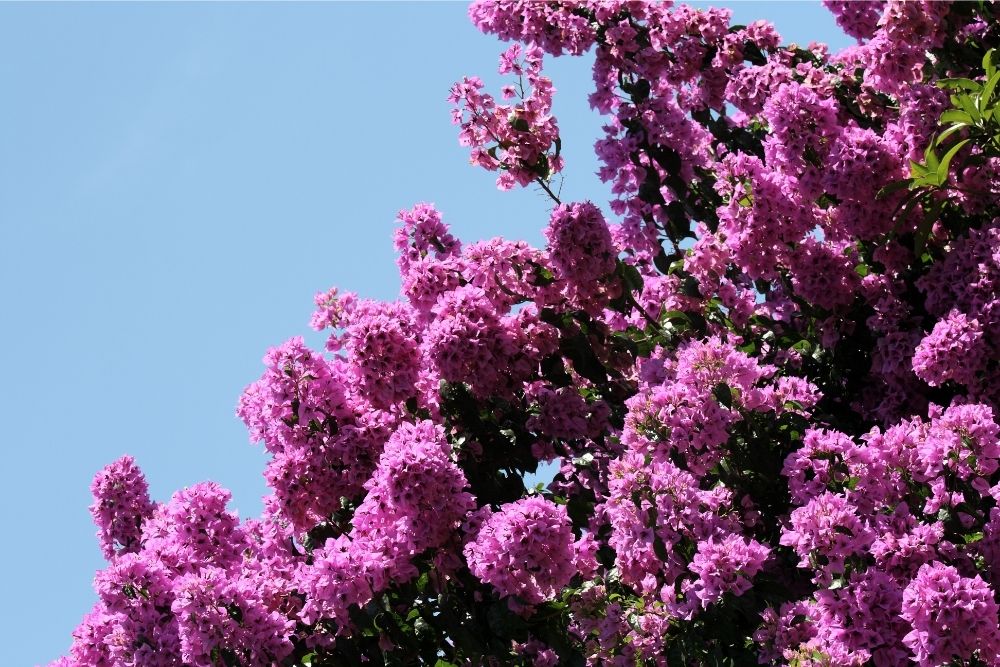
However, there’s nothing more stunning than a tree blooming with purple leaves and flowers.
These days, there are many varieties of trees that boast purple foliage, whether that includes shades of lilac, lavender, or violet.
So if you want to know more about these species, then you have come to the right place.
In the following article, we have compiled a list of purple trees, so that you can learn more about the different varieties and their meanings.
These trees either sport purple blooms or leaves, so there is a tree for everyone.
So if you want to discover more about these magical trees, this article has everything you need to get started…
1. Crepe Myrtle (Lagerstroemia)
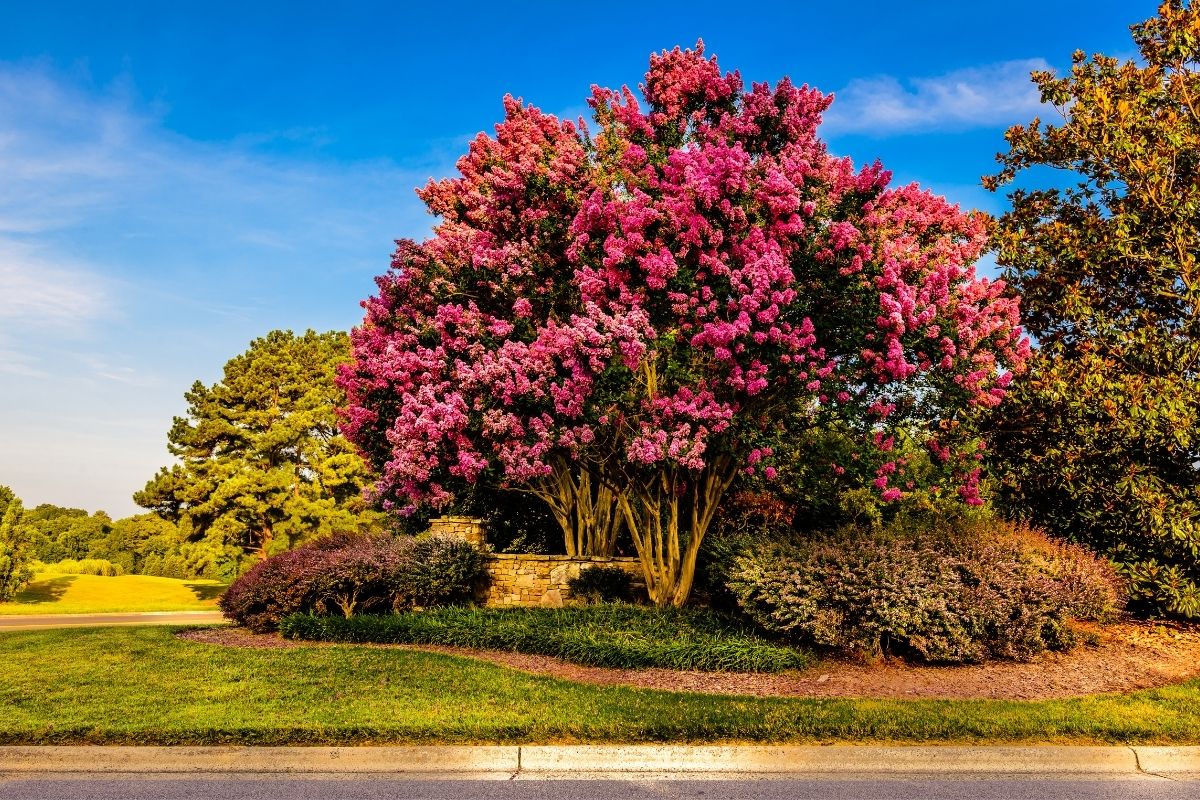
For the first tree on our list, we have chosen a popular species native to the Indian subcontinent, where it is known for its long-lasting and vibrant flowers.
While the crepe myrtle is known for its purple blooms, this does not mean that the species is only available in one color, as it can also come in red, pink, and white.
2. Chaste Tree (Vitex Agnus-Castus)
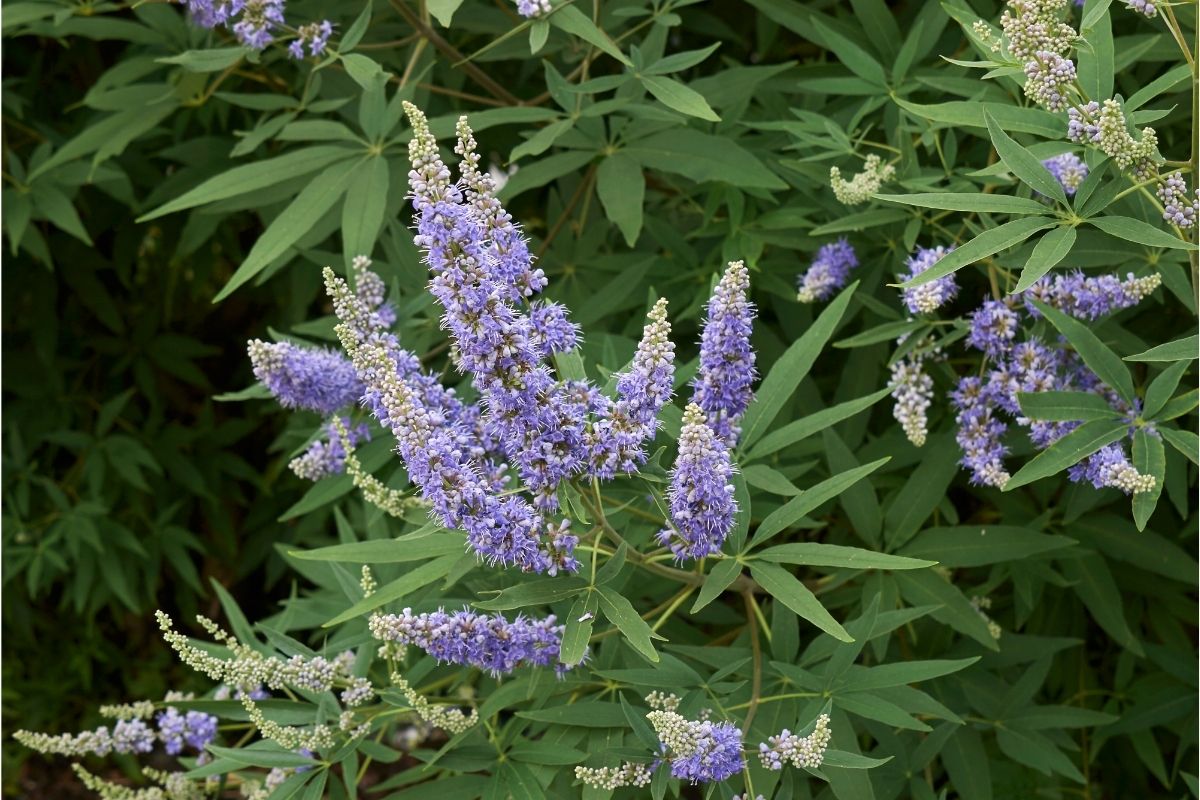
Distinguished by its small size, the chaste tree is often mistaken for a shrub and will commonly bear purple or blue flowers.
The species is native to the Mediterranean, where it will bloom during the late summer and attract various butterflies.
3. Jacaranda Tree (Jacaranda Mimosifolia)
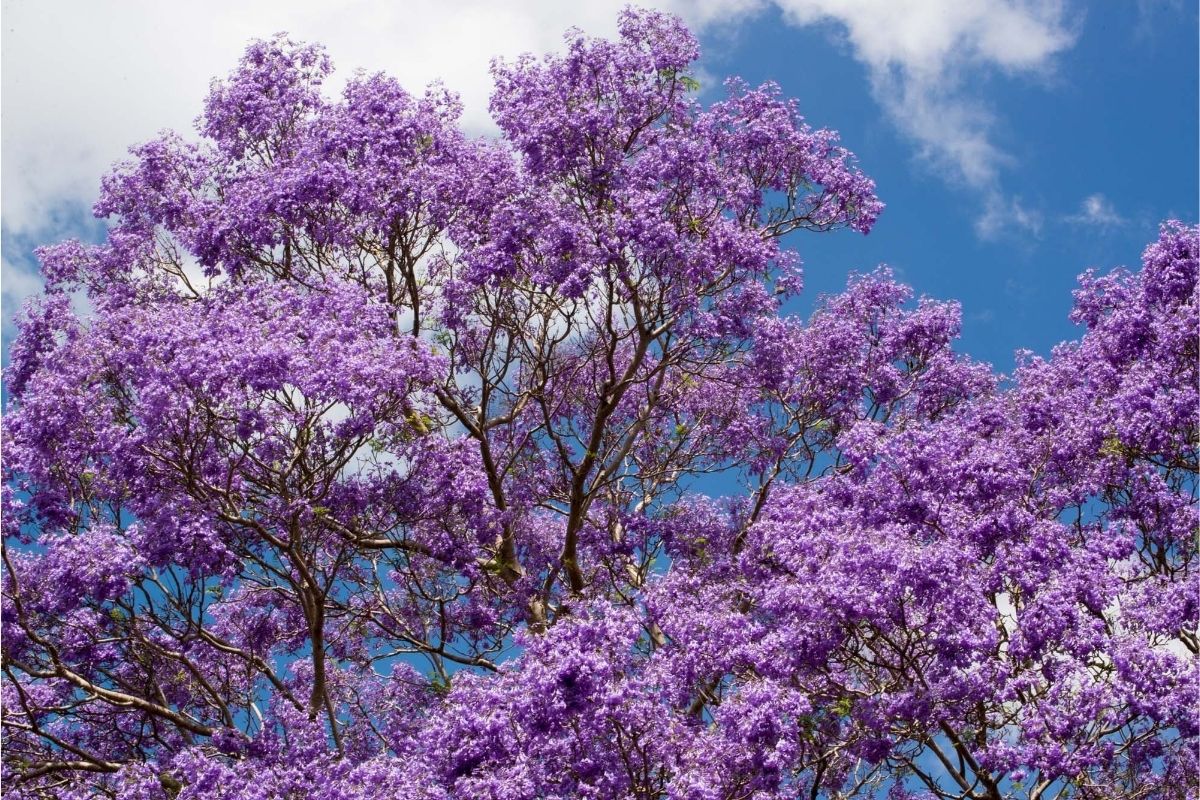
The jacaranda tree is a vibrant species found in subtropical areas, where it will bloom during the spring and early summer.
The species is capable of reaching 66 feet (ca. 20 m) and can be identified by its trumpet-shaped flowers, which are known for their distinctive wisteria hue.
4. Purple Robe Locust (Robinia Pseudoacacia)
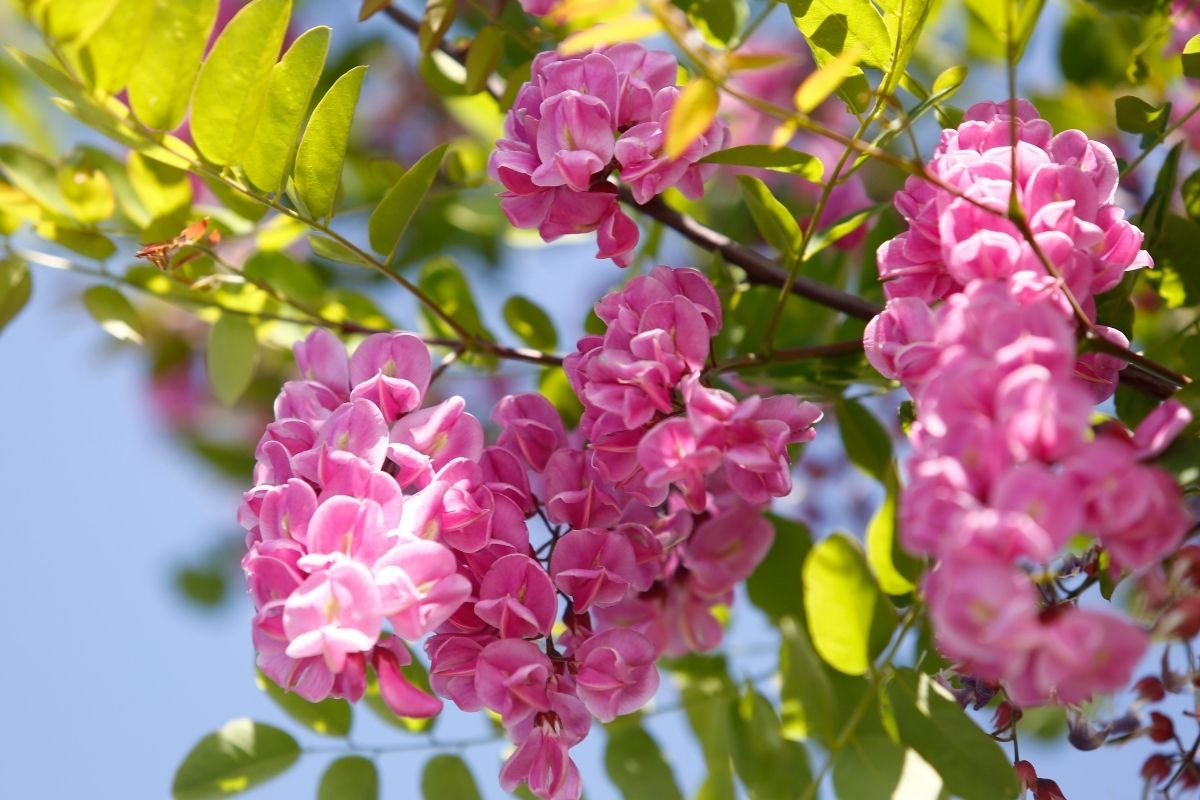
Despite being known for its delicate flowers, the purple robe locust is a durable species that can survive in harsh and deadly conditions.
Capable of thriving in a variety of soils, this tree is cultivated for its ability to attract bees and butterflies, who will seek out the locust once it has bloomed.
5. Purple Orchid Tree (Bauhinia Purpurea)
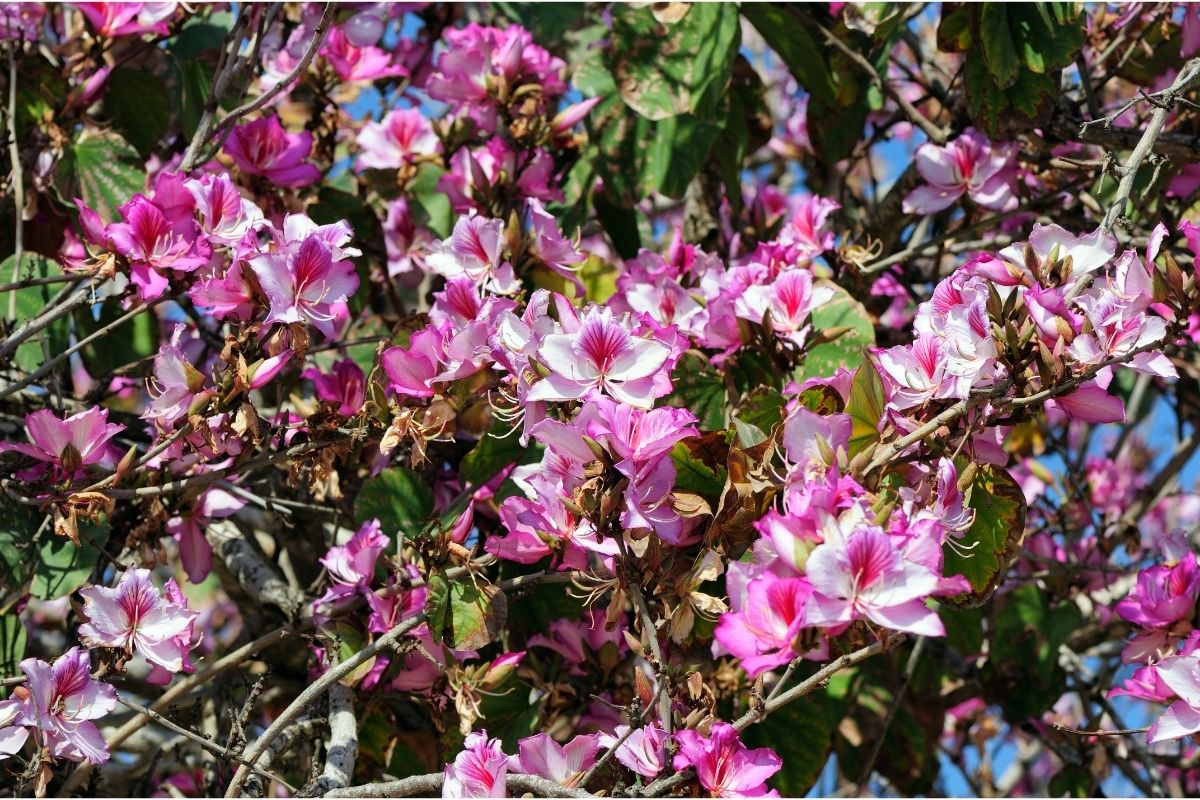
The purple orchid tree is a tropical species that is native to the Indian subcontinent, where it stands up to 17 feet tall.
The tree will bear its flowers from summer to winter, with the blooms being characterized by their white whiskers and fuchsia tone.
6. Fragrant Lilac (Syringa Vulgaris)
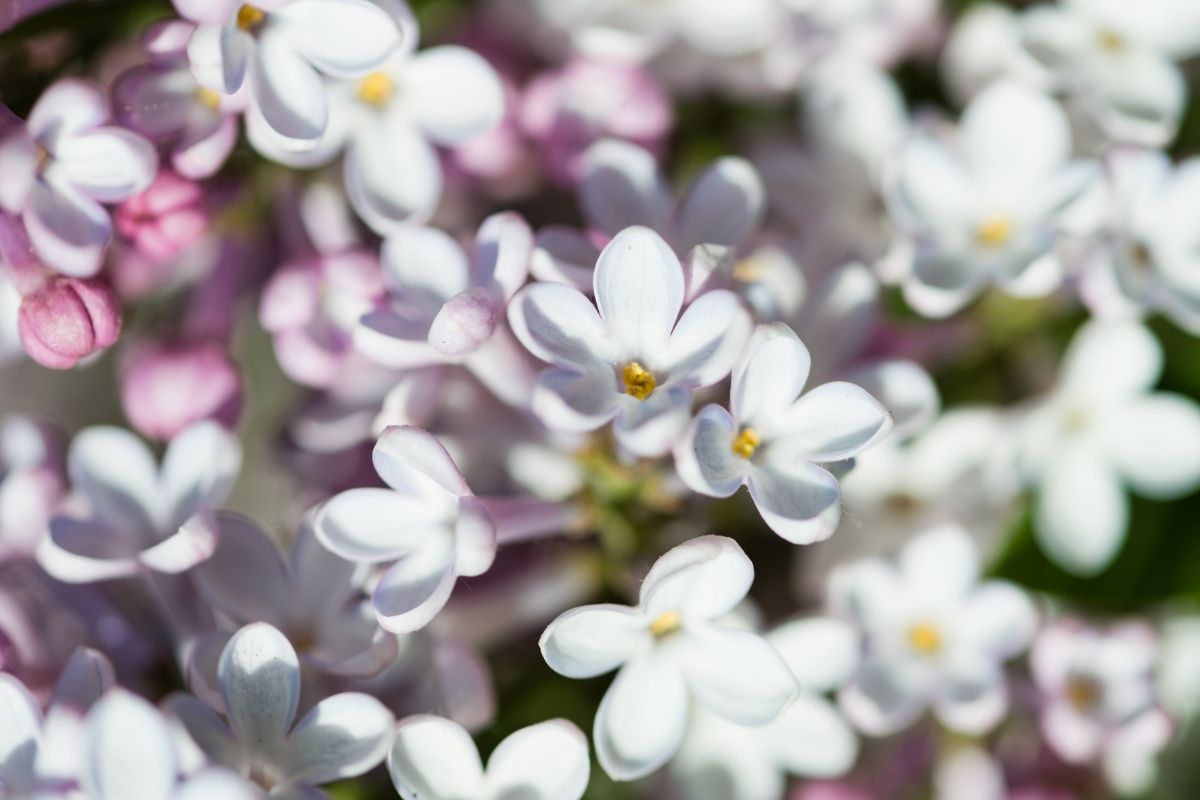
Known for its delicious fragrance, this majestic species is native to southeastern Europe, where it remains a popular choice for gardens and parks.
The tree will commonly bloom during the late spring and is known to bear long-lasting flowers in shades of lilac and lavender.
7. Purple Lily Magnolia (Magnolia Liliiflora)
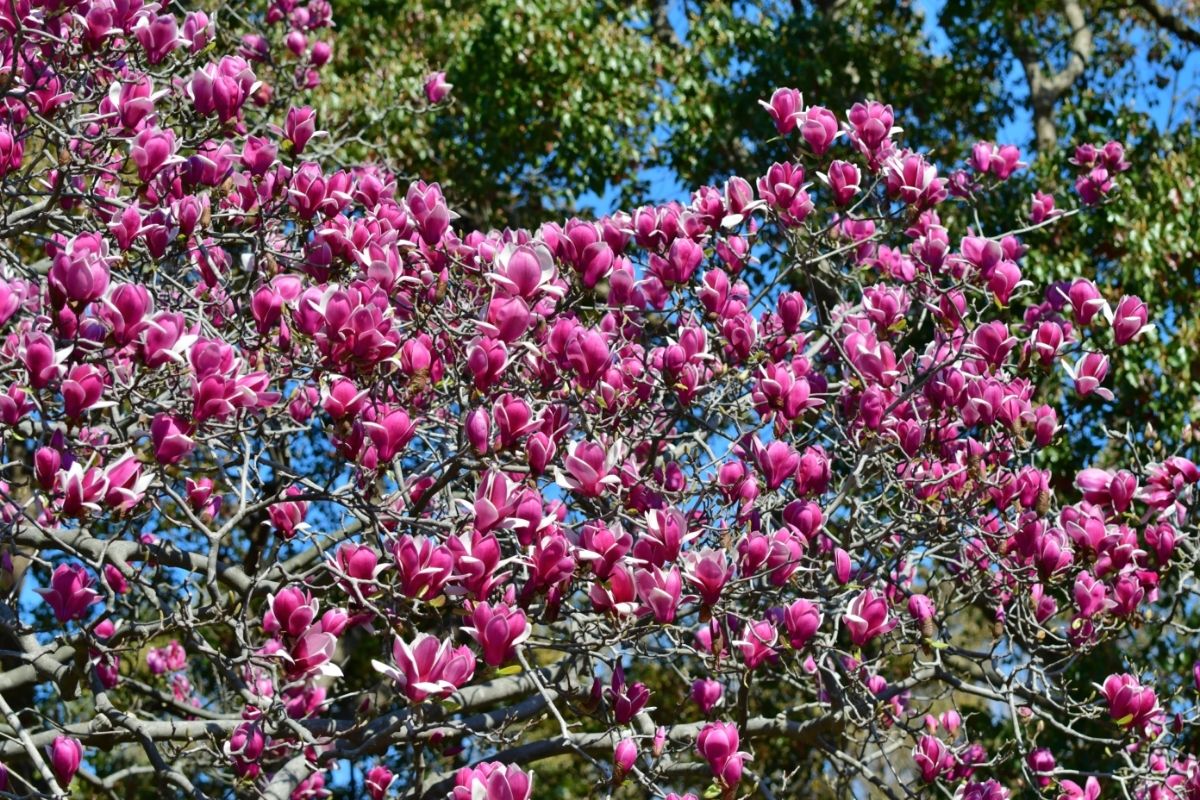
This deciduous shrub can be found across China and Japan, where it will bloom in the spring and bear seven petalled flowers.
The small tree stands between 8 – 12 feet tall and will grow in acidic soil – however, the species can suffer due to harsh weather and a lack of warmth.
Related: 20 Stunning And Easy To Grow Purple Houseplants (With Pictures)
8. Desert Willow (Chilopsis Linearis)

Despite its name, the desert willow is actually a proud member of the catalpa family and can be found in the southwestern United States and Mexico.
The large shrub can only reach a maximum height of 30 feet and can be identified by its trumpet-shaped flowers, which come in shades of purple and pink.
9. Royal Purple Smoke Tree (Cotinus Grace)
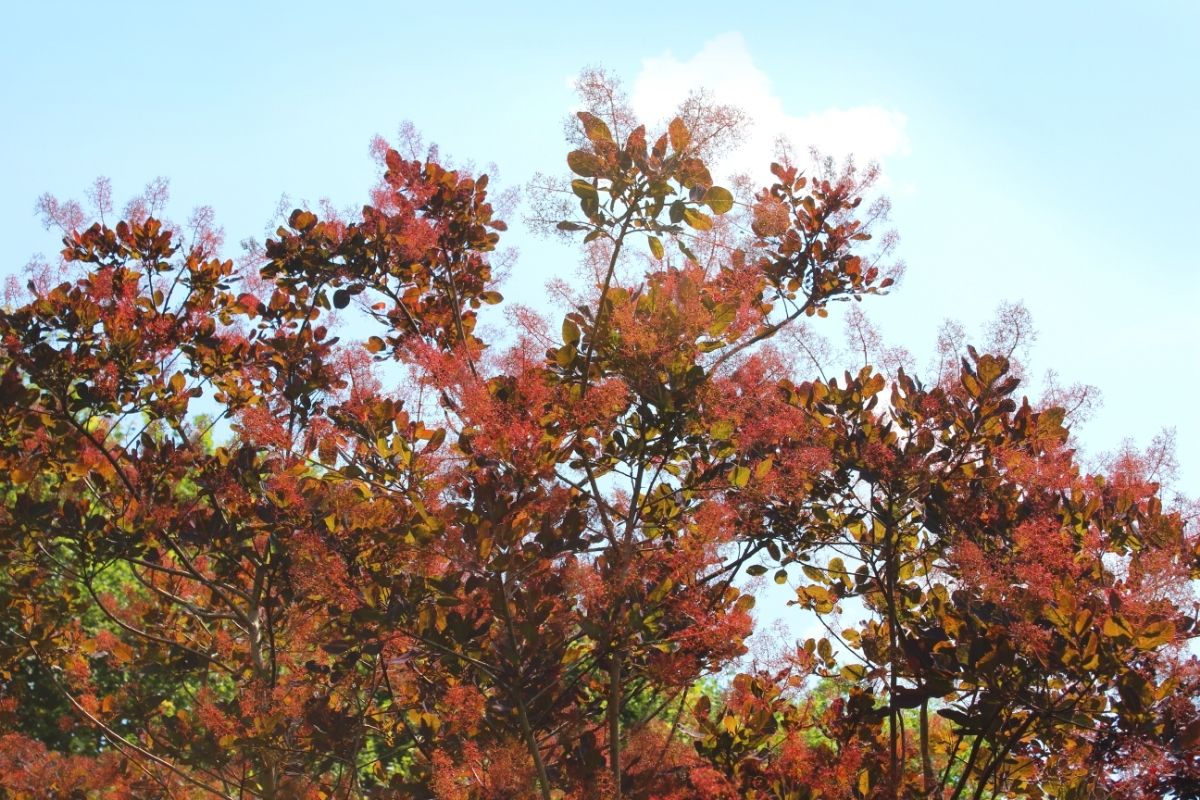
The smoke tree is said to represent beauty and power, as it produces smoke-like blooms and can survive in a variety of climates.
The species will commonly bloom during the summer, where it will reach heights of 15 feet and bear red-purple leaves.
10. Royal Empress Tree (Paulownia Tomentosa)
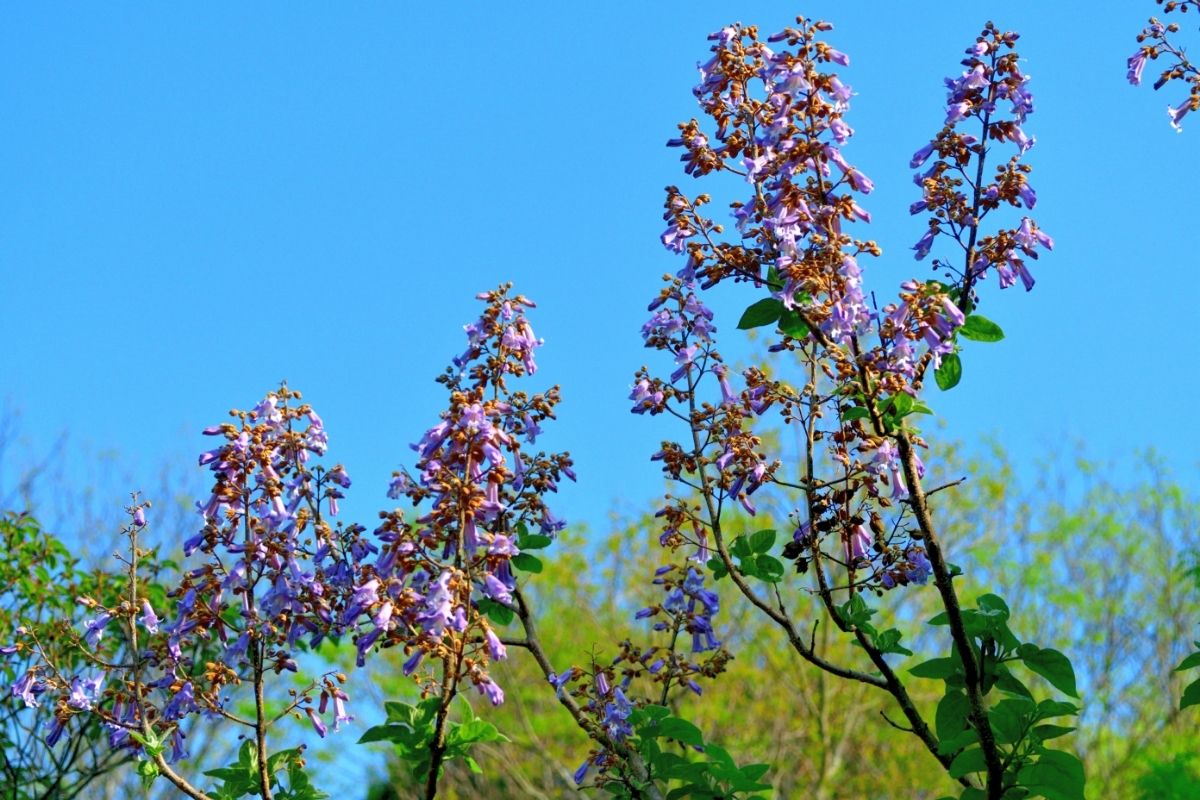
Considered the world’s fastest-growing shade tree, the royal empress will commonly bloom in the spring, where it will bear purple-blue flowers with a sweet scent.
Capable of reaching between 40 – 50 feet tall, the tree is extremely beneficial for the environment, as it can absorb over 48 pounds of carbon dioxide and convert it into fresh oxygen.
11. Korean Lilac Tree (Syringa Meyeri Palibin)
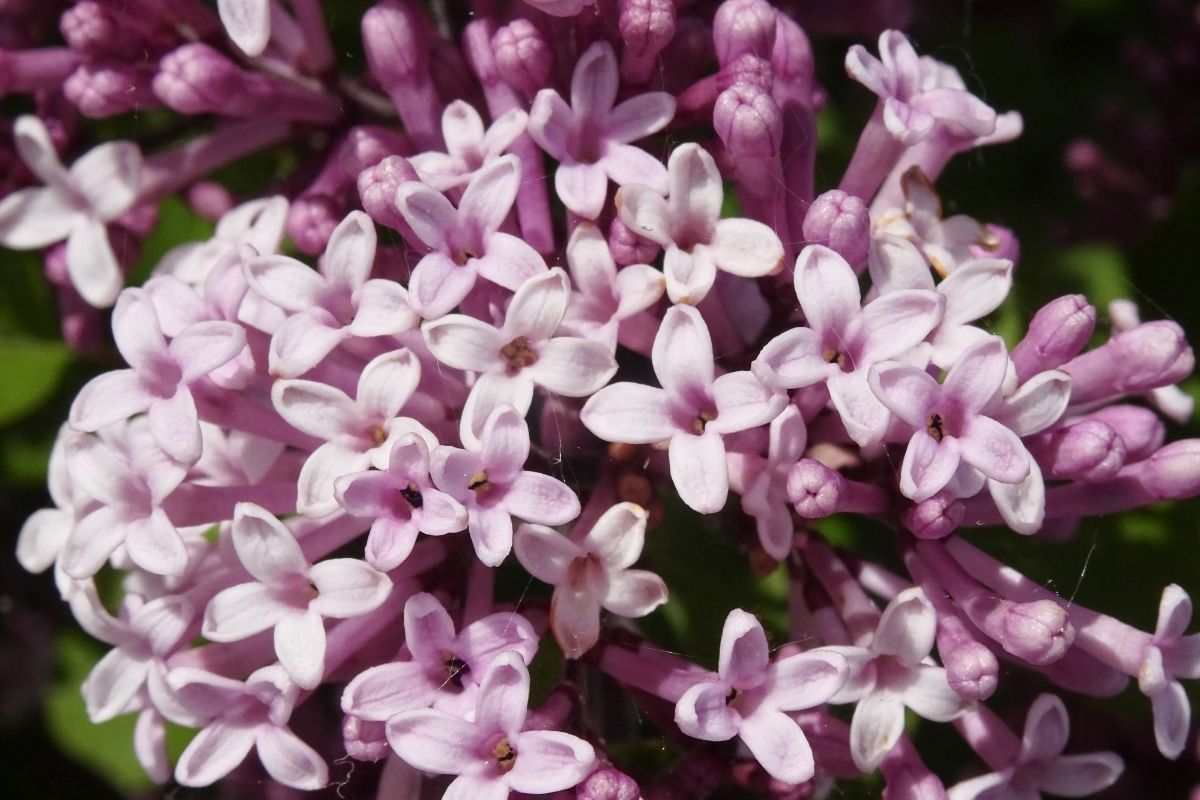
The Korean lilac tree first gained popularity among lilac enthusiasts and gardeners, with the species being chosen for its spring blooms and purple petals.
Known as a low-maintenance tree, the species is commonly used as a patio shrub, although it can also look beautiful in gardens and landscapes.
12. Texas Mountain Laurel (Sophora Secundiflora)
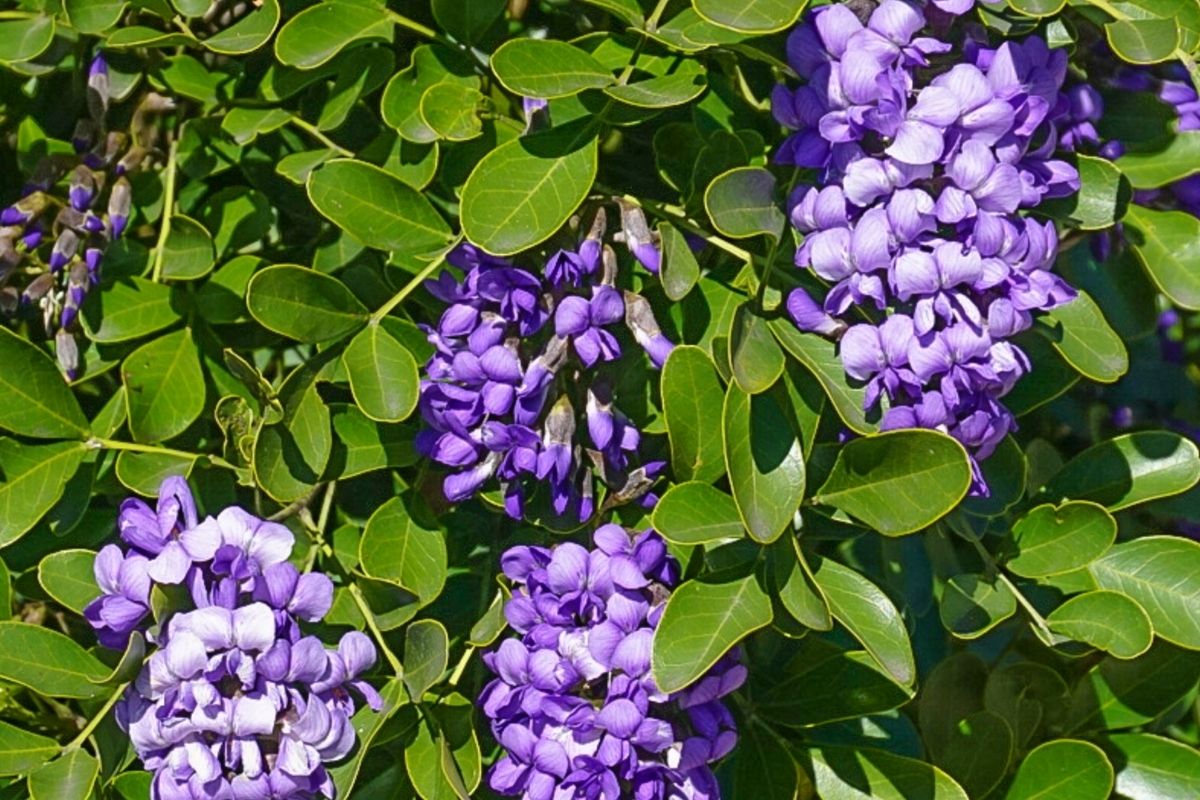
The Texas mountain laurel is a beautiful evergreen shrub that blooms during the spring and summer, where it will produce fragrant fronds of purple flowers.
The species is known to thrive in shady areas and can reach up to 30 feet tall without the need for regular pruning.
13. Purple Leaf Plum Tree (Prunus Cerasifera)
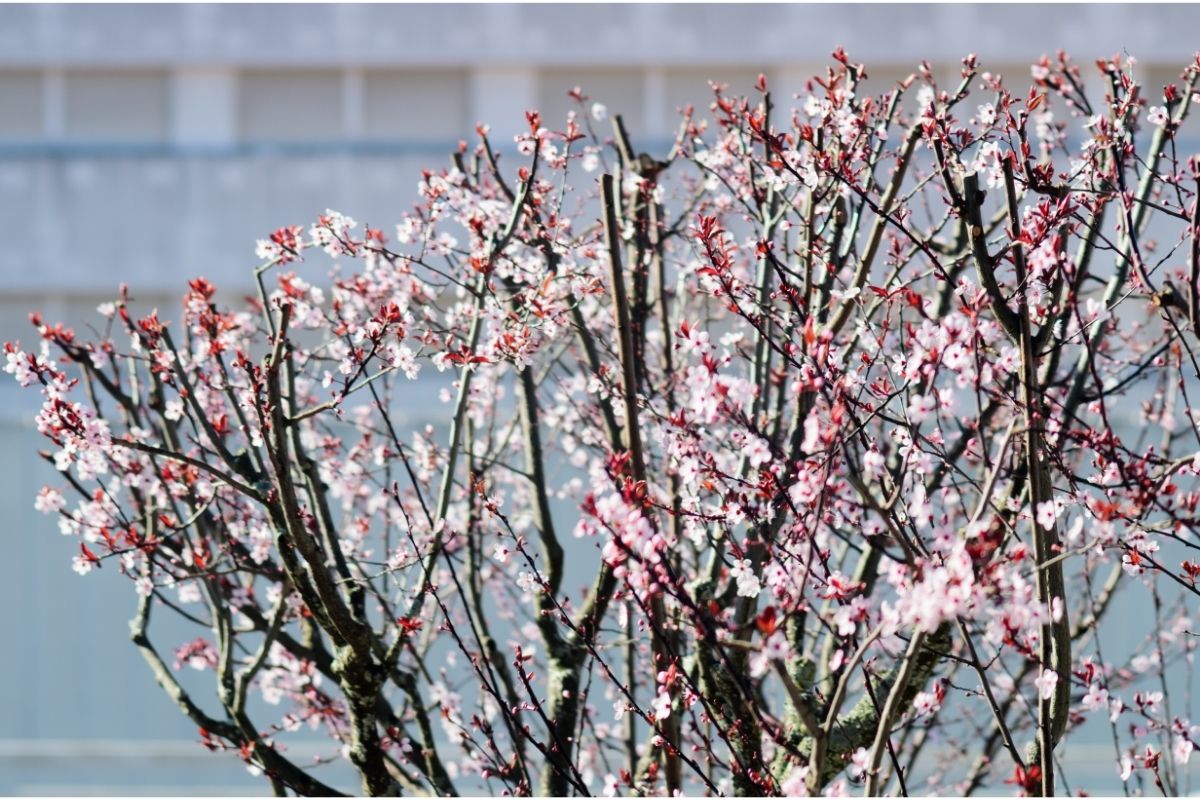
Unlike the other species we have discussed, this deciduous tree does not bear purple blooms – instead, it produces pale pink flowers during the early spring.
However, the tree is worth showcasing due to its remarkable red-purple leaves, which make the tree the perfect accent to any garden or landscape.
14. Red-Silver Crabapple (Malus Red-Silver)
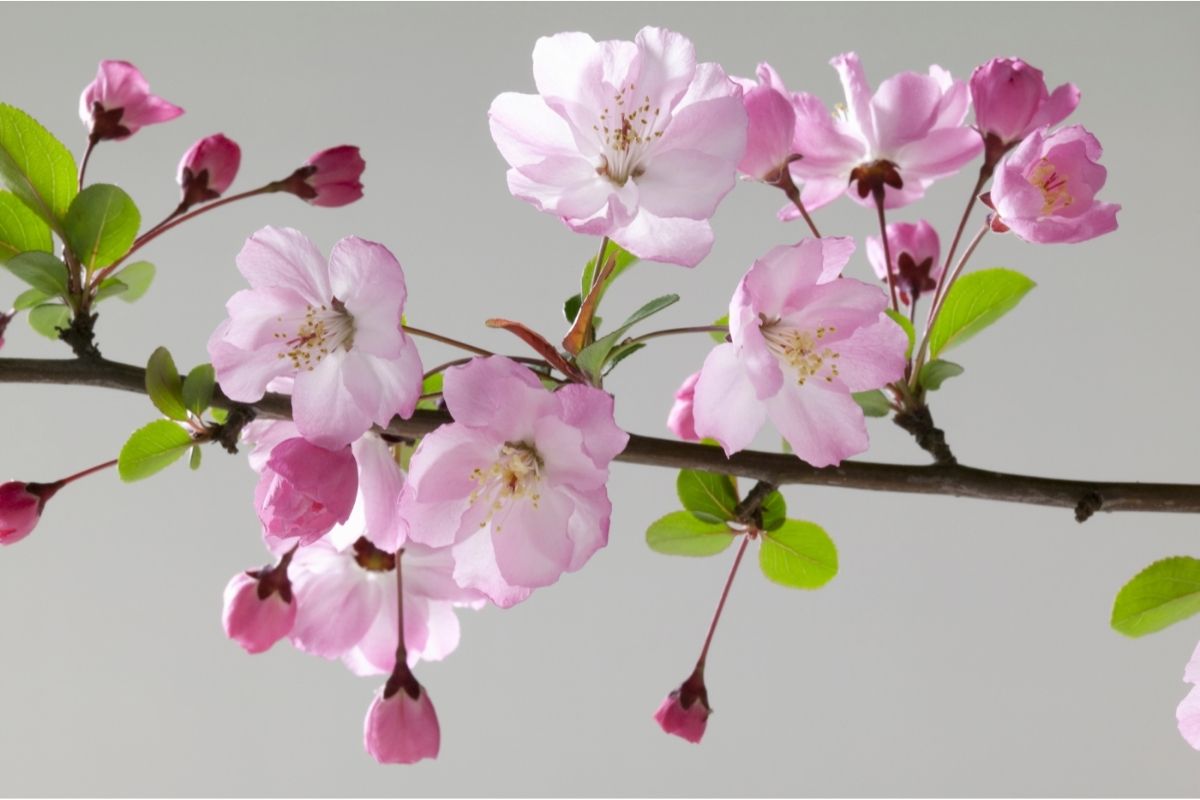
This semi-sweeping tree is best known for its handsome appearance, with the species also producing its own edible fruit.
Described as dense and fragrant, the leaves of this tree can be distinguished by their silver hairs and red-purple tone.
15. Helmond Pillar (Berberis Thunbergii)
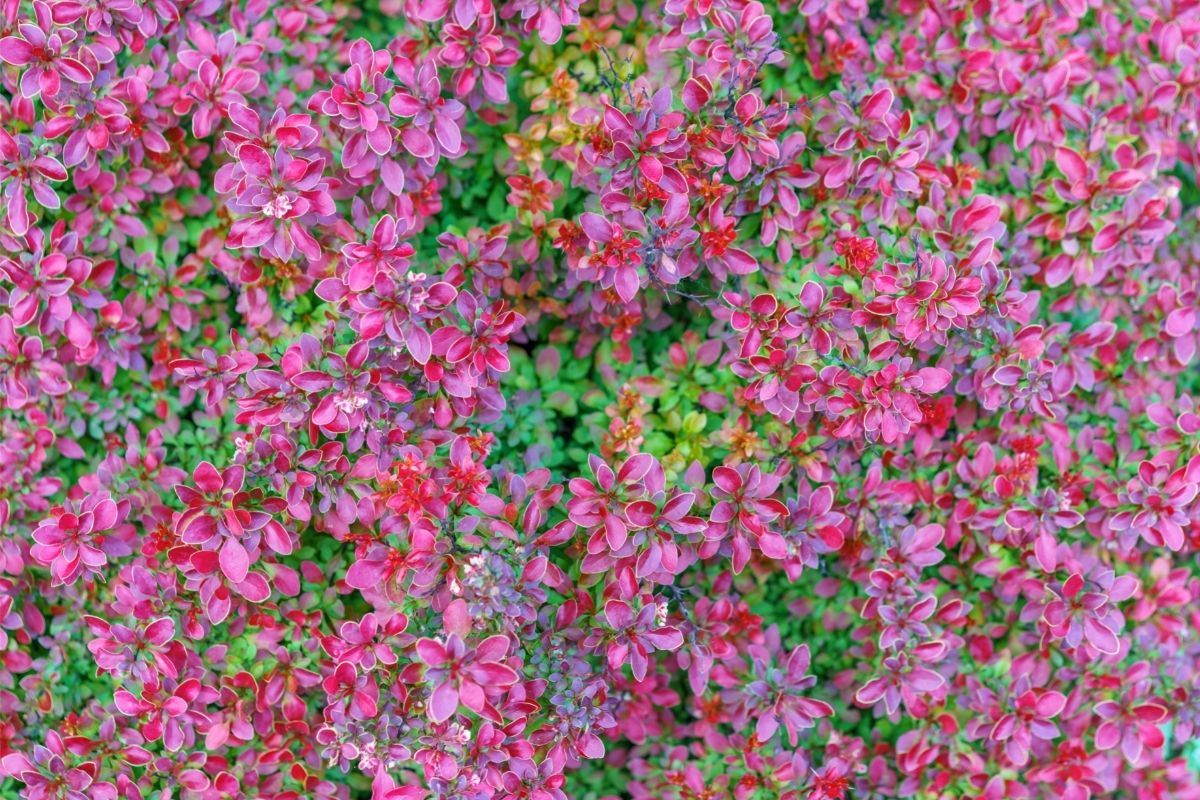
Desired by landscapers and gardeners, the Helmond pillar is a tree known for its hardy nature and deep purple-red leaves.
A proud member of the barberry family, this species can make for a dazzling addition to any garden, especially when it has been planted alongside flowering bushes and evergreen shrubs.
16. Black Elderberry (Sambucus Nigra Purpurea)
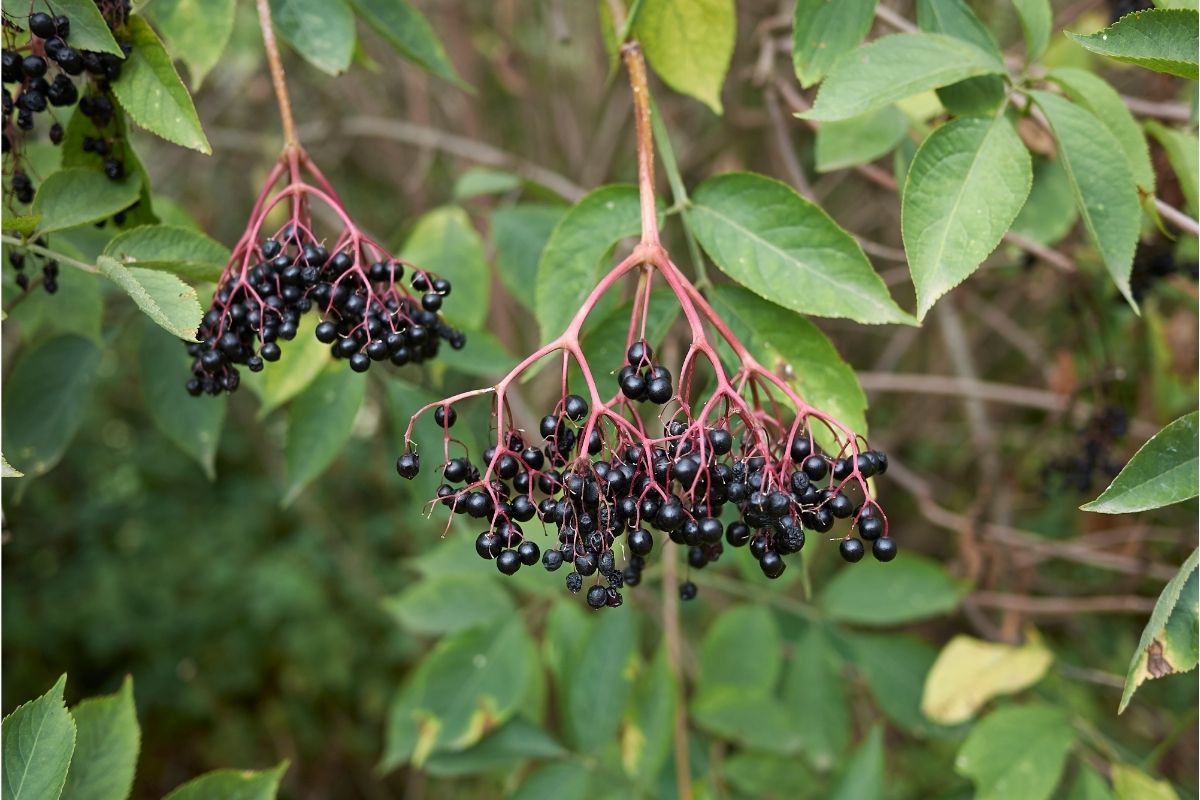
While the black elderberry is known for its pale red flowers, the tree is also notable for its dark purple leaves, which remain the same color throughout the year.
Classed as a deciduous shrub, the species can grow at a moderate rate and reach up to 20 feet tall, with the tree also bearing delicious berries that can be harvested throughout the summer.
17. Cherry Plum (Prunus Cerasifera Newport)
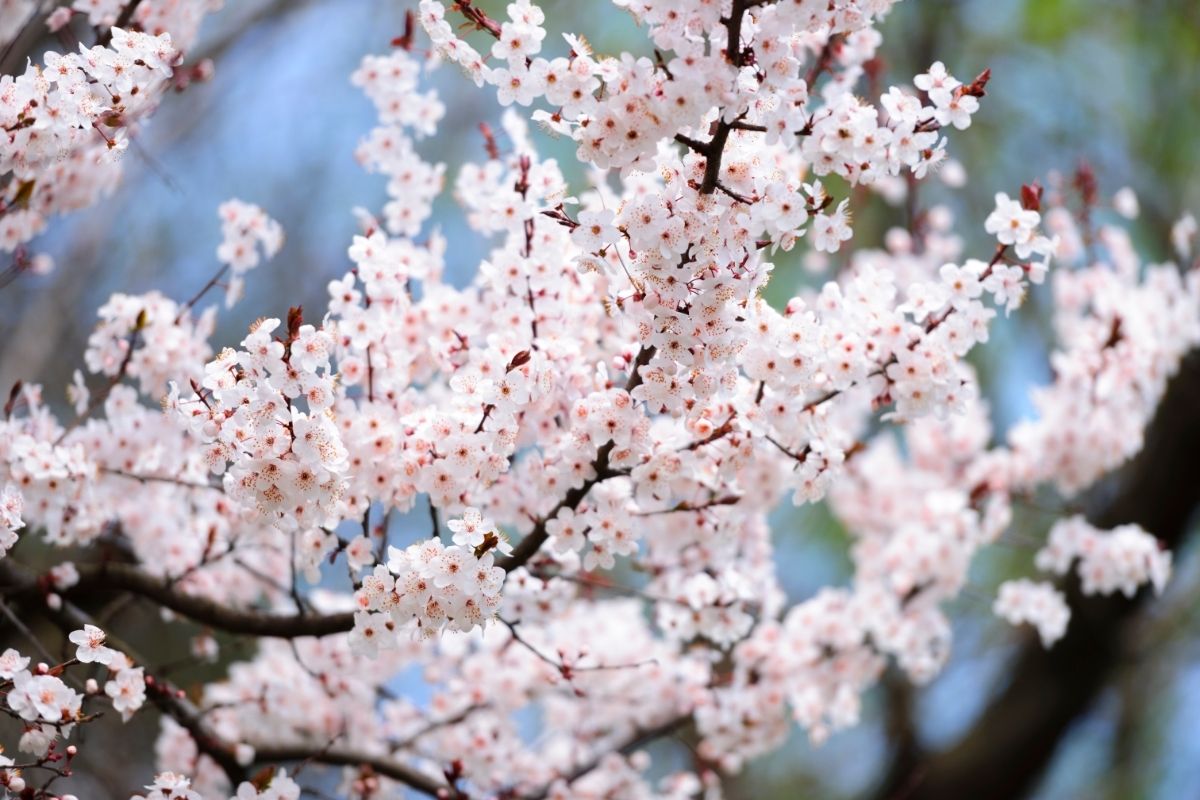
The cherry plum is a beautiful tree cultivated for ornamental purposes, as it produces pale blooms and dark purple leaves.
While the foliage remains purple throughout the year, the shades will change depending on the season, with the leaves changing to bronze-purple in the spring and red-purple in the fall.
18. Japanese Maple Tree (Acer Palmatum)
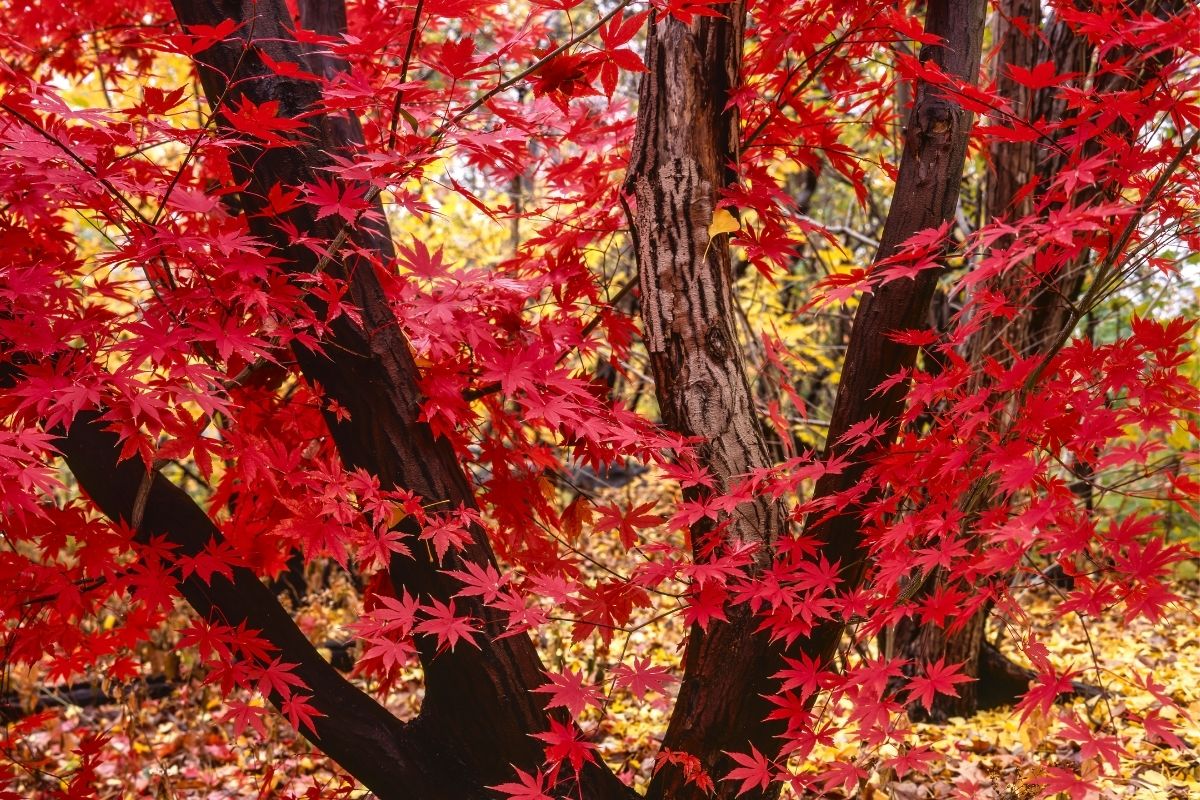
The Japanese maple is a species of tree native to Mongolia and North Korea, where it can be found in gardens and forests.
Classified as a deciduous shrub, the small tree is known for its purple-red leaves, which are said to resemble outstretched hands.
19. Purple-Leaf Sand Cherry (Prunus x Cistena)
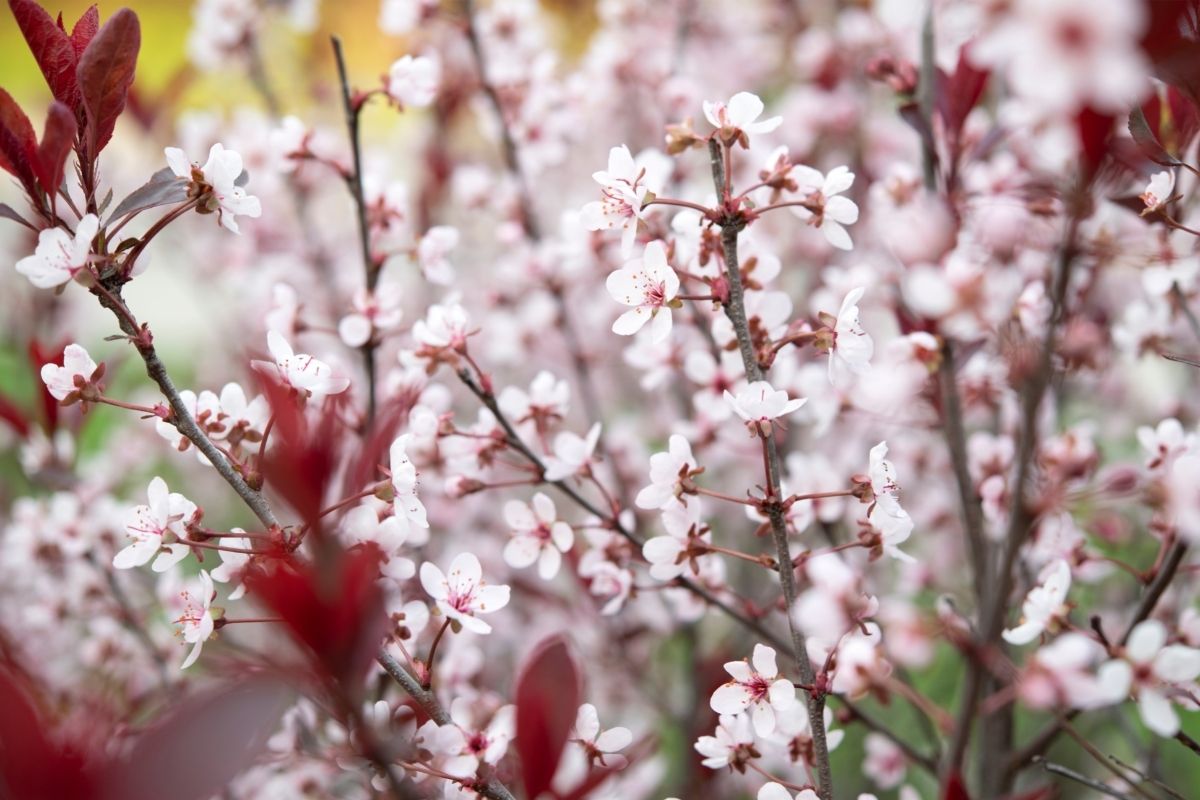
This hybrid species is a cross between prunus pumila and prunus cerasifera, which makes it a resilient and vibrant shrub known for its purple leaves.
The only downside to this species is its short lifespan, with most specimens only reaching a decade before death.
20. Japanese Barberry (Berberis Thunbergii Atropurpurea)
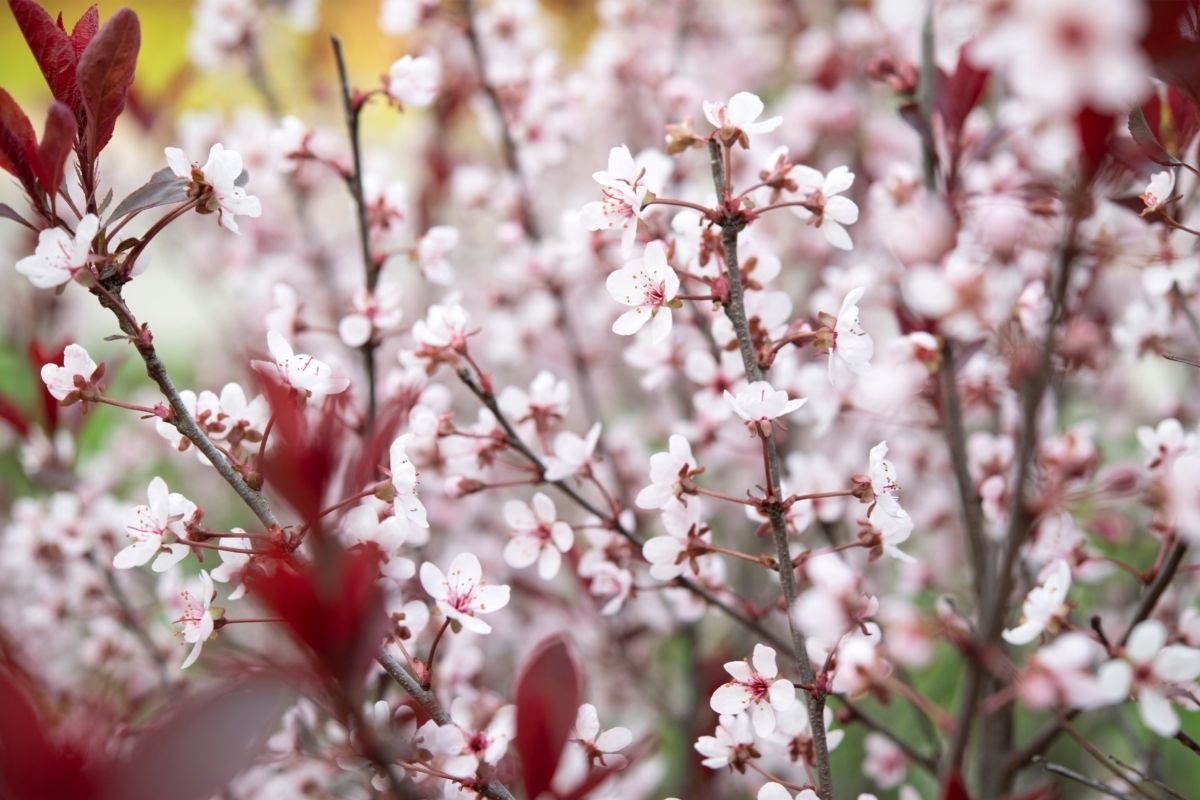
Known for its robust and tolerant nature, the Japanese barberry will bloom during the spring and summer, where it will produce yellow blossoms and purple leaves.
The species can be grown in any soil and looks beautiful in open spaces, especially when it has been planted in direct sunlight.
21. Midnight Rose (Heuchera)
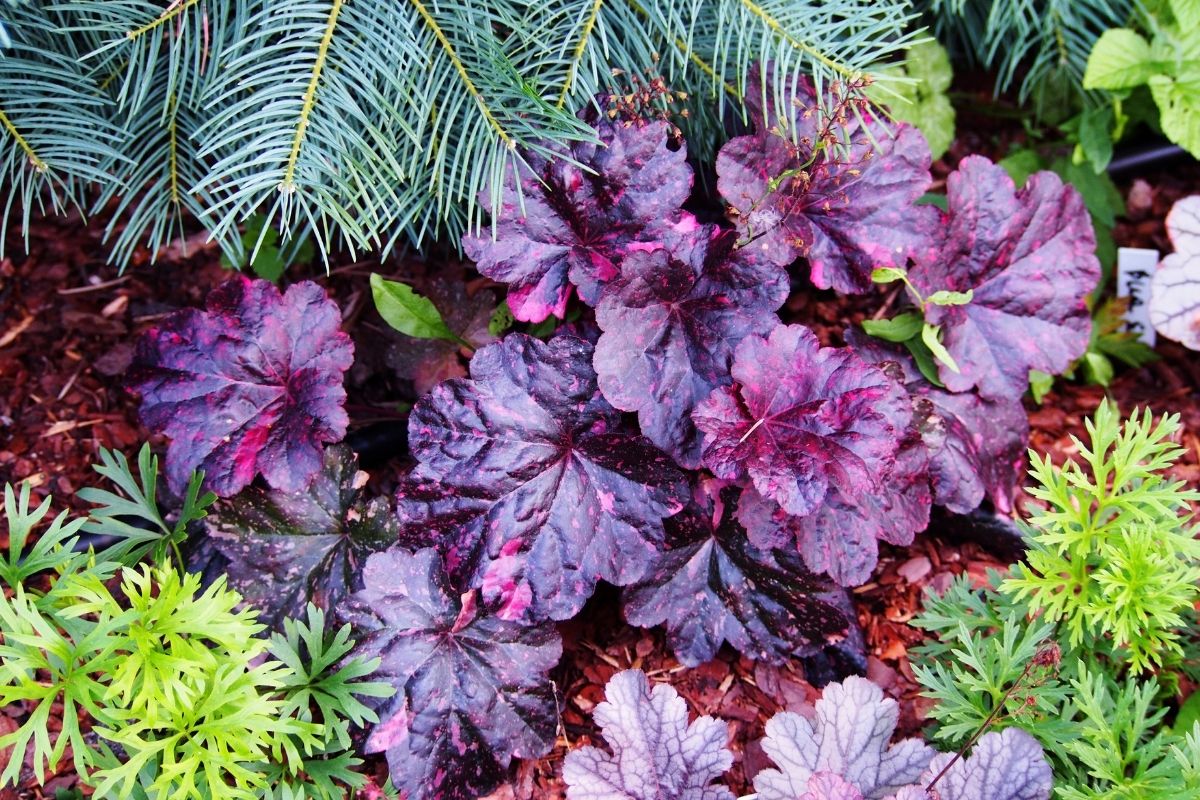
While not technically a tree, the midnight rose is a beautiful plant known for its marbled foliage, which makes it a controversial species among enthusiasts.
The leaves of the plant will remain purple throughout the year, although in the spring it will also acquire hints of magenta and pink.
22. Purple-Leaf Acacia (Acacia Baileyana Purpurea)
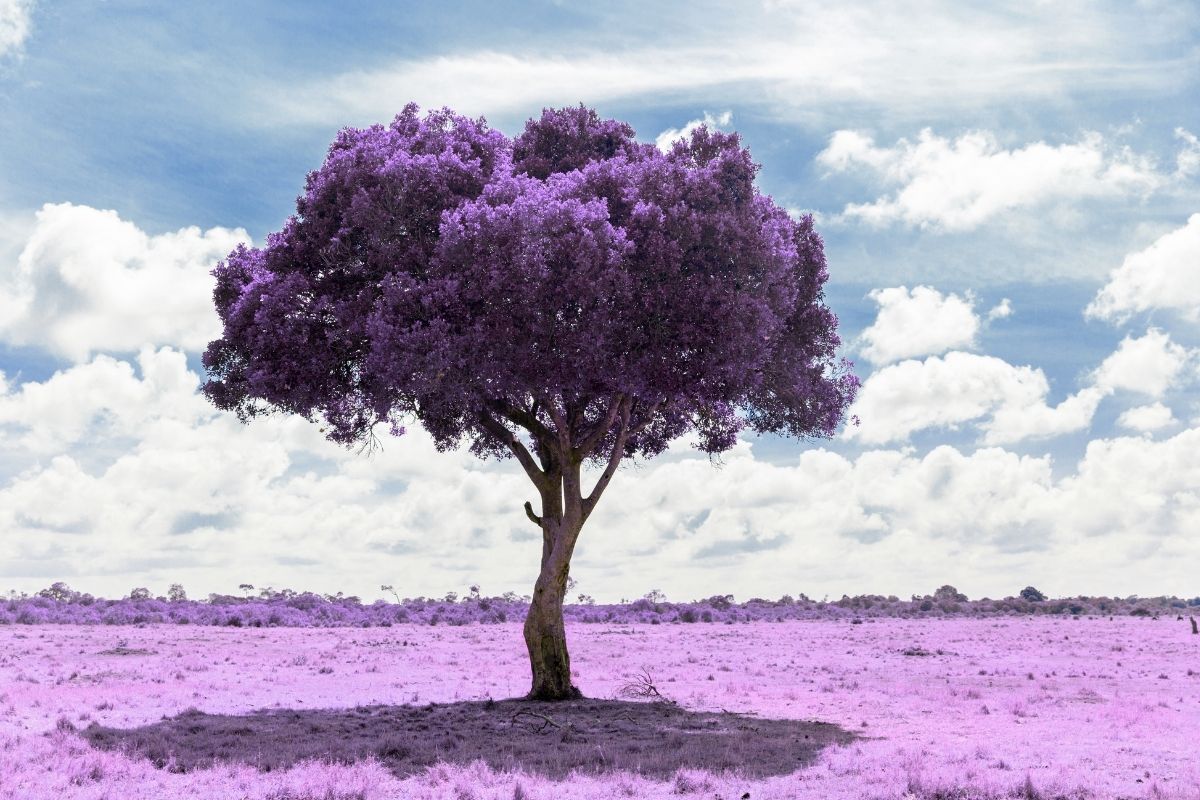
This vibrant shrub first originated in the Australian outback, where it bears purple leaves and can reach 15 – 20 feet tall.
While the foliage will remain purple throughout the year, the species will also produce yellow flowers during the spring and summer, with the leaves also taking on a bronze tone during this time of the year.
23. Crimson King Maple (Acer Platanoides)
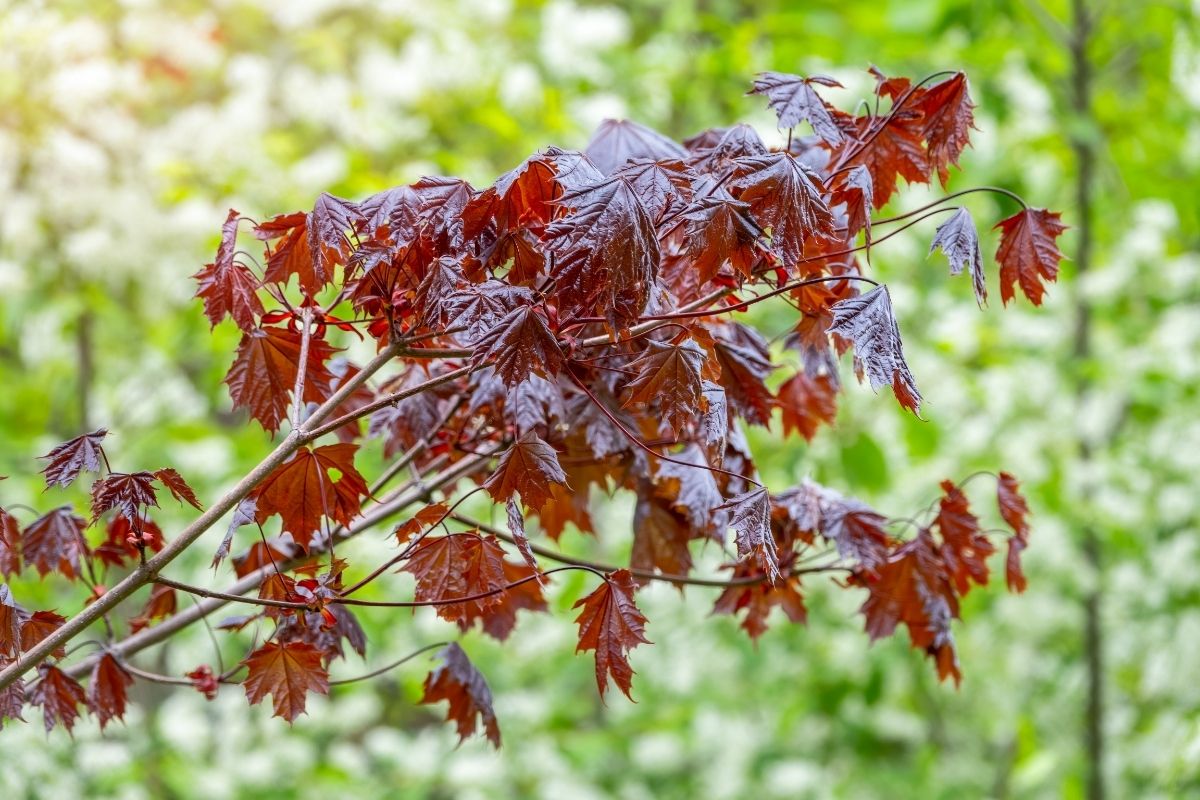
Growing to 35 feet tall, the crimson king maple is a beautiful tree that thrives in sunny and shaded areas, where it must be planted in well-drained soil.
The foliage of this tree takes on a gorgeous purple-red, which can look stunning when paired with bushes and evergreen trees.
24. Japanese Wisteria (Wisteria Floribunda)
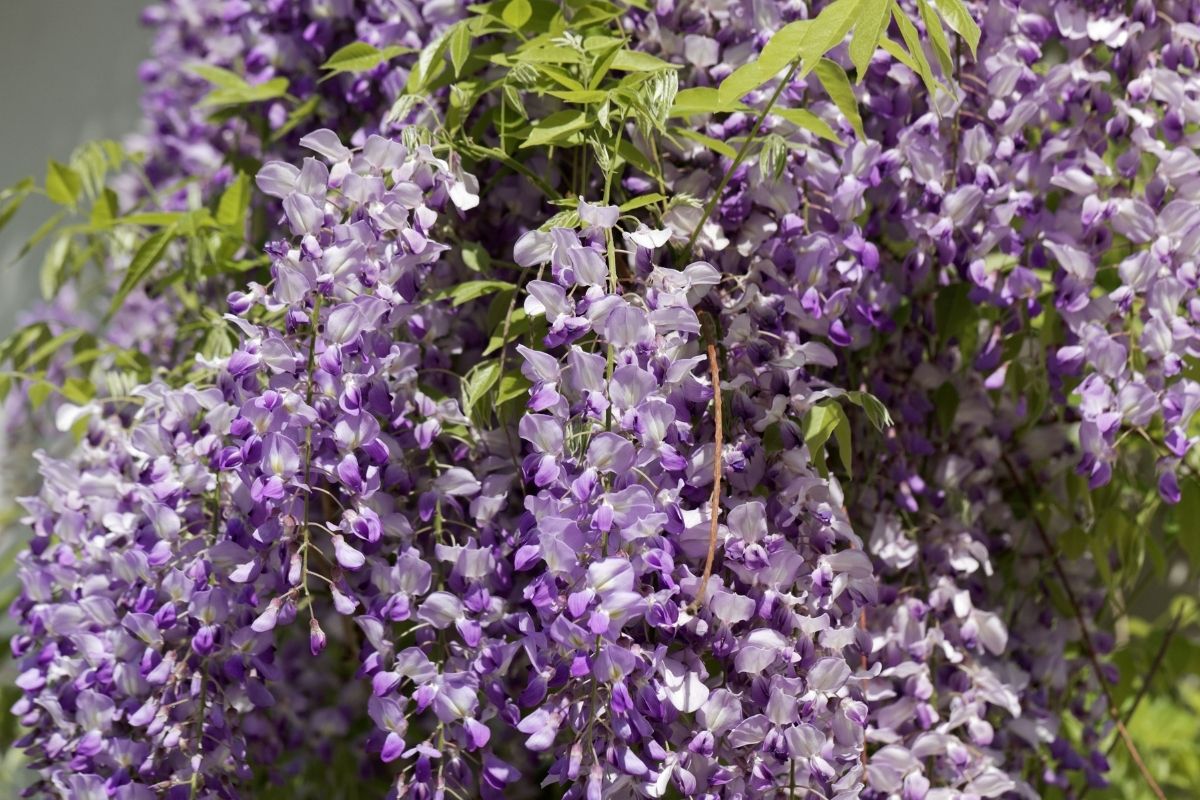
While wisteria is not considered a species of tree, we have decided to showcase the climber for its beautiful fronds, which come in shades of lilac and lavender.
Native to Japan, the species has become a popular ornament in gardens across the world, where it is used to decorate buildings and walls.
Conclusion
As you can see, there are countless purple trees available in the world, with each species boasting its own characteristics and personality.
Now that you understand the variety of species available, it’s time to consider which purple tree would look the best in your garden.
Editor’s Recommendations
Shade in Asia: 16 Different Types Of Asian Trees







